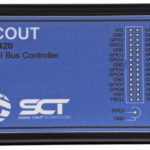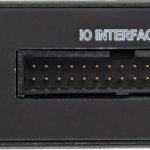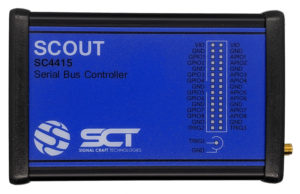Scout Model SC4420
Serial Bus Controller (MIPI-SPMI, MIPI-I3C, and MIPI-RFFE)
Production Status: Active

Download
Testimonial
"Once again thank you for the amazing support and SC4420 [unit]. I can see why it is at nearly every customer I visit."
Martin Lim, RF Component Technologist, Rohde & Schwarz USA
- USB-to-Serial Bus Controller Provides Deterministic Serial Communications
- Fit, form and functional compatible with the SC4415
- Supports MIPI-SPMI V1.0 and V2.0, MIPI-I3C V1.0 (w/ Legary I2C) and MIPI-RFFE V3.0, and SPI
- Software-Selectable Clock Rates (mode dependent) supporting 100 kHz to 60 MHz
- Several Triggering Modes
- Software Trigger
- External SMA Input
- External GPIO Input
- 8 General Purpose I/O (GPIO)
- Designed for High Volume Production Environments
- Field Upgradeable
- Wide Operating Temperature Range (0 °C to 70 °C)
Typical Applications
- Design Verification Testing (DVT)
- High Volume Production Test
- RF Design and Characterization
The SC4420 is a third-generation device in the Scout family. It was designed to be fit, form and function compatible with the SC4415. Scout is the highest performing MIPI controller on the market. Unlike other USB-based serial bus dongles, Scout products are designed for high-speed test and control applications. Architected around an FPGA, the SC4420 ensures that all timing and control functions are deterministic. The device is targeted at verification benches and high-volume production test applications requiring reliable operation over millions of test sequences.
The Scout SC4420 represents the next generation in the Scout product line. It incorporates enhanced features and has options to support MIPI-RFFE, MIPI-I3C, MIPI-SPMI, I2C and SPI protocols in single master mode.
The test interface incorporates serial bus, GPIO and triggering functions. This interface connector provides flexibility, several interconnect-cabling options, and helps to minimize noise coupling. The interface voltage (VIO) is software selectable. For non-standard interface voltages, Scout can be configured to accept an external voltage reference. Several triggered command buffers provide scripting capability for high speed test and verification applications. Triggering modes include internal (software command) and external options (via GPIO or the trigger input).
Scout instantiates itself as a standard COM port via USB. The unit supports manual operation using a terminal emulator or fully automated control in ATE environments via any programming language support.
- MIPI-SPMI V1.0 and V2.0
- MIPI-I3C V1.0 (with Legacy I2C)
- MIPI-RFFE V3.0
- SPI Modes 1 to 4
Sequencing and Timing
Scout was designed with determinism, low latency, and fast execution in mind. Timing-critical performance is achieved by using FPGA hardware and user-configurable command cues. Users can define a command sequence and trigger multiple executions of the sequence using either software or hardware triggers.
GPIO
Eight GPIO are available in all operating modes, and each one can be configured as either an input or an output. The GPIO commands can be embedded in the command queue and executed alongside other serial protocol commands. GPIO timing is deterministic.
External Supply
The adaptor can be powered via USB, eliminating the need for an external power supply. For applications where the USB host may be current starved, an external 5 Vdc power supply can be used to power the device.
Buffering and Trigger Modes
The SC4420 incorporates an instruction sequencer to accelerate high-volume production test applications. These high-capacity buffers can be recalled by activating one of several trigger modes. Two buffers of 1024 instructions each can be filled and replayed in instruction sequencer style.






